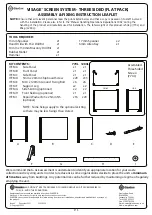
3
FRAME ASSEMBLY
1. Unpack the frame parts from the carton. Do not
unroll the screen surface at this time.
2. To prevent damage to the speaker covers, it is
recommended to assemble the screen frame in
an upright position as shown in diagram 1. If the
frame is too tall to attach the top section, carefully
lay the frame on a clean surface with the snaps
facing up.
3. The top and bottom pieces are labeled
accordingly. Slide the side sections onto the
bottom frame section. The plastic corner will slide
inside the side frame section. The steel corner will
be located on the outside of the side frame
section. Use 3-#10x1" screws at each corner to
secure the plastic corner. Use 2-#10x1/2" screws
at each corner to secure the steel corner.
4. Slide the top frame section onto the side frame
sections. The plastic corner will slide inside the
side frame section. The steel corner will be
located on the outside of the side frame section.
Use 3-#10x1" screws at each corner to secure the
plastic corner. Use 2-#10x1/2" screws at each
corner to secure the steel corner.
5. Install 1 snap stud at each corner.
RIGHT SPEAKER
BINDING POST
TERMINAL
RETAINER
BRACKET
DIAGRAM 1
SNAP STUD
4-PIECES
#10X1/2" SCREW
2-PIECES
CENTER
SPEAKER BINDING
POST TERMINAL
LEFT SPEAKER
BINDING POST
TERMINAL
#10X1" SCREW
12-PIECES
#10X1/2" SCREW
8-PIECES
INSTALLATION
The wall bracket must be secured to a reinforced area of
the wall, such as a wall stud. Use 1/4" screws that will
reach at least 1" into the wall stud.
1. Attach the wall bracket to the wall. The bracket
must be level. You will need at least 1/2" clearance
above the wall bracket to mount the frame.
2. Stand the screen near the wall that it will be
mounted on.
3. SPEAKER CONNECTIONS: Speakers and
electronic components have corresponding (+)
and (-) terminals. Most manufacturers of speakers
and electronics use red to denote the (+) terminal
and black to denote the (-) terminal. The (+) lead of
the wire is noted with a stripe. It is important to
connect all speakers identically: (+) on the speaker
to (+) on the amplifier and (-) on the speaker to (-)
on the amplifier. Wiring “out of phase” results in
thin sound, weak bass and poor stereo image.
4. To attach the left, center and right speaker wires
to the binding post terminals on the back of the
frame, unscrew the colored collar until the pass-
through hole in the center of the post is visible
under the collar. Insert the bare end of the wire
through the hole; then screw the collar down until
the connection is tight. The holes in the center of
each collar can also be used for banana-type
connectors.
DIAGRAM 2
WALL
BRACKET
5. Lift the assembled screen onto the wall bracket.
See diagram 2. Be sure it is fully seated on the
bracket.
6. Install the retainer brackets on the bottom of the
frame with #10x1/2" screws. the screw hole is
located 3/4" from the end of the frame and 7/16"
from the back of the frame. See diagram 1.
6. Carefully unroll the screen surface. The viewing
side is rolled to the inside of the roll. Start at the
top corners and snap the viewing surface onto the
frame. Secure the snaps along the top, then down
the sides and then along the bottom.






























